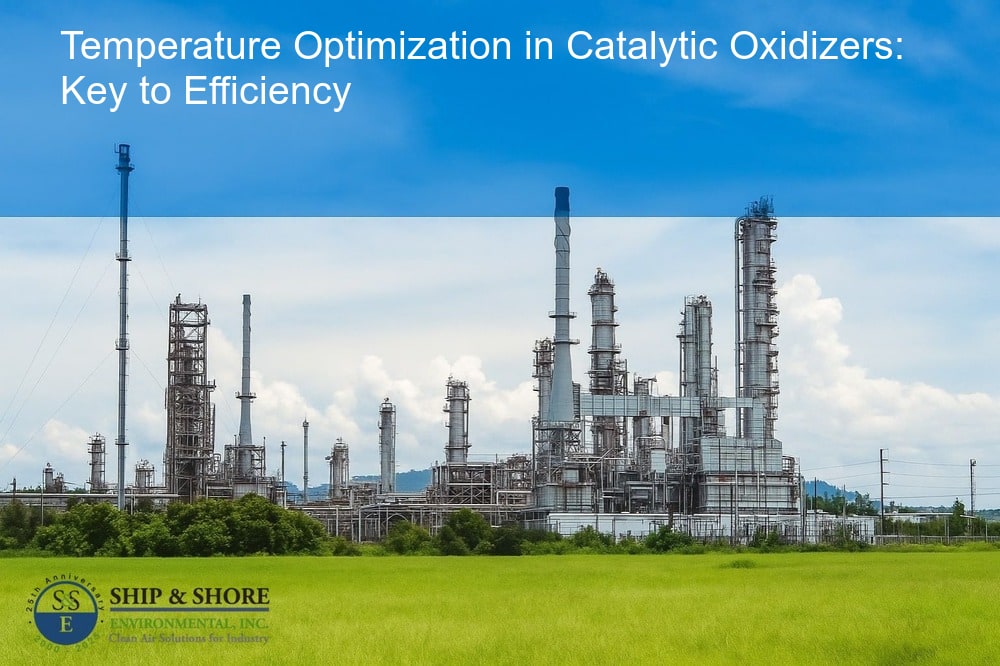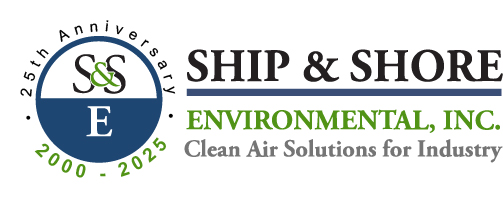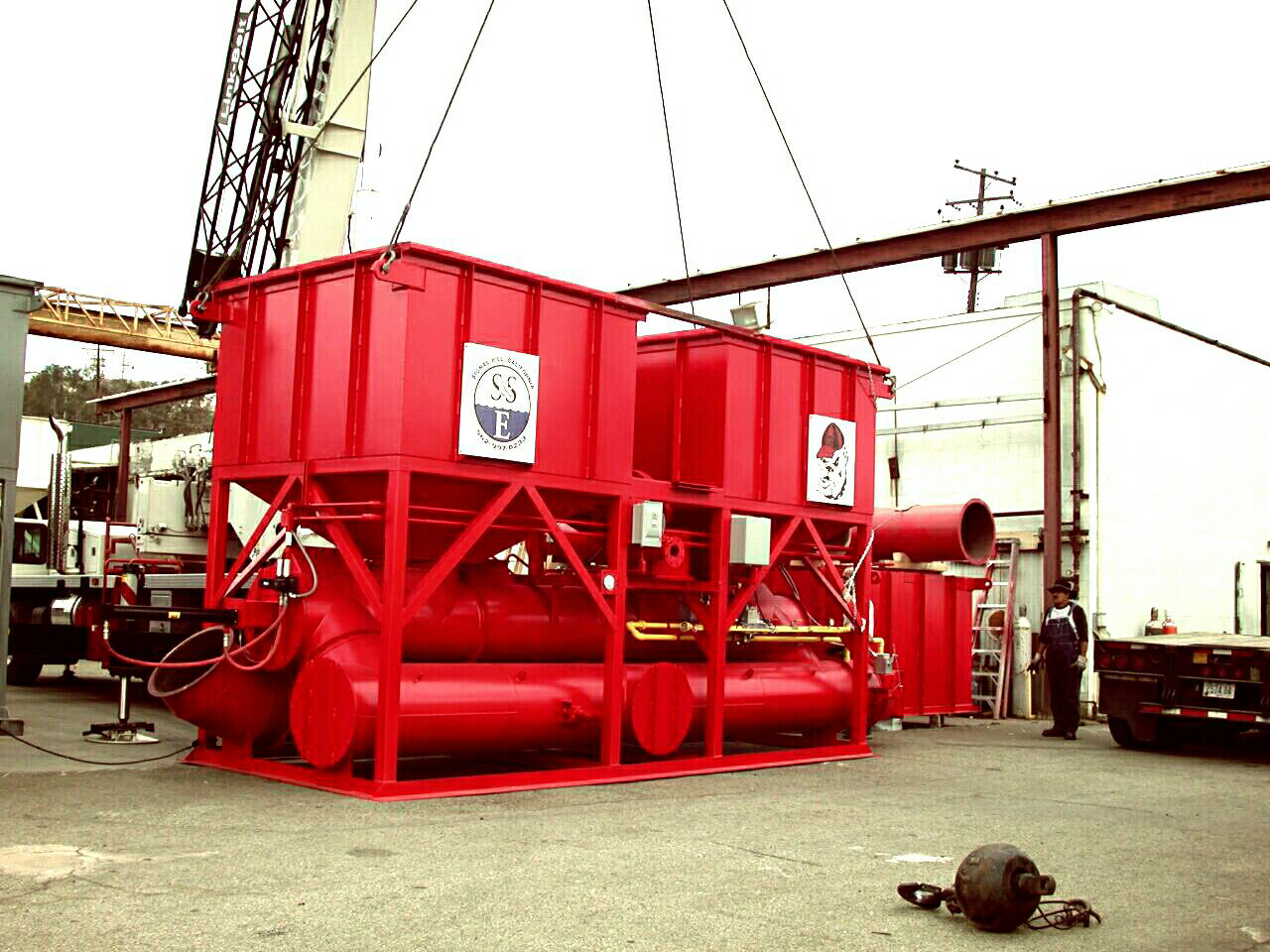
Maximizing Efficiency: Temperature Optimization in Catalytic Oxidizers
August 4, 2025 12:55 amRecognizing the Role of Catalytic Oxidizers in Industrial Processes
Temperature optimization in catalytic oxidizers is a significant factor in enhancing industrial efficiencies. Catalytic oxidizers play an essential role in various industrial processes by reducing harmful emissions and converting volatile organic compounds (VOCs) into less harmful substances. As industries progress toward more sustainable practices, the role of catalytic oxidizers becomes increasingly important in maintaining environmental compliance and operational efficiency.
At Ship & Shore Environmental, Inc., we are committed to supporting industries in optimizing their processes. Tailoring the temperature conditions in catalytic oxidizers can dramatically improve their performance, leading to not only better environmental outcomes but also cost savings and process efficiency.
The Critical Influence of Temperature Regulation in Performance
The performance of catalytic oxidizers is highly dependent on their operating temperature. Too high a temperature can lead to excessive energy consumption and potentially damage the catalyst, resulting in increased operational costs. Conversely, too low a temperature can reduce the efficiency of VOC conversion, leading to incomplete oxidization of contaminants and potentially failing to meet regulatory standards.
Our experience at Ship & Shore Environmental, Inc. indicates that precise temperature regulation is vital. By maintaining the optimal temperature, catalytic oxidizers can achieve peak performance, balancing energy use and pollution control effectively. This balance ensures that industries can operate both sustainably and economically.
Introduction to the Concept of Temperature Optimization in Catalytic Oxidizers
Temperature optimization in catalytic oxidizers refers to the strategic regulation of operating temperatures to maximize efficiency and performance. This process involves a meticulous analysis of the specific operational requirements and conditions of each catalytic oxidizer. Critical parameters such as the nature of the VOCs being treated, the flow rate, and the specific characteristics of the catalyst must be considered.
We at Ship & Shore Environmental, Inc. employ advanced techniques and technologies to achieve this optimization. By leveraging state-of-the-art control systems and real-time monitoring tools, we ensure that the temperature within catalytic oxidizers is maintained at an optimal level, thus enhancing their effectiveness and longevity. Embracing temperature optimization creates a pathway towards achieving improved environmental compliance and operational cost savings.
Factors Impacting Temperature Regulation in Catalytic Oxidizers
The efficient operation of catalytic oxidizers relies heavily on precise temperature management. One of the key factors affecting temperature regulation is the quality and type of catalyst used. Different catalysts have varying optimal temperature ranges and reactivity. Therefore, selecting the right catalyst for specific applications becomes crucial. In addition, the airflow rate is another critical element. By carefully managing the airflow rate, we can maintain a stable temperature, ensuring the catalyst remains in its optimum operating range.
Component wear and tear also have a significant impact on temperature regulation. Over time, components such as fans, sensors, and heating elements can degrade, leading to fluctuations in temperature. Regular maintenance and timely replacement of worn-out parts are essential to prevent performance issues. Furthermore, environmental conditions such as ambient temperature and humidity levels can influence the effectiveness of the oxidizer. Therefore, monitoring these factors helps in achieving consistent performance.
Techniques for Effective Temperature Optimization in Catalytic Oxidizers
Several advanced techniques can be employed to achieve effective temperature optimization in catalytic oxidizers. Firstly, implementing advanced control systems is a vital technique. Modern control systems use sensors and automation to continuously monitor and adjust the temperature within the oxidizer. These systems can quickly respond to any temperature deviations, ensuring the system operates within the desired range.
Another useful technique is heat recovery, where excess heat generated during the catalytic oxidation process is captured and reused. This not only improves the overall energy efficiency but also helps maintain a stable temperature within the system. Additionally, regular calibration of temperature sensors ensures that accurate readings are obtained, enabling precise control over temperature fluctuations.
Key Techniques for Temperature Optimization:
- Implementing Advanced Control Systems
- Utilizing Heat Recovery
- Regular Calibration of Temperature Sensors
- Maintaining Component Efficiency
- Monitoring Environmental Conditions
An often-overlooked technique is the proper insulation of the oxidizer unit. Effective insulation minimizes heat loss, making it easier to maintain the desired temperature range. This not only optimizes performance but also leads to significant energy savings. Moreover, using variable frequency drives (VFDs) for fans and pumps allows for better control of airflow rates, directly impacting temperature management.
Real-World Benefits Gained From Temperature Optimization
Implementing temperature optimization in catalytic oxidizers results in numerous real-world benefits. Firstly, optimized temperature control enhances the overall efficiency of the oxidization process. By consistently operating within the optimal temperature range, we achieve higher conversion rates, reducing the emission of harmful pollutants. Furthermore, this leads to compliance with stricter environmental regulations, demonstrating our commitment to sustainability.
Secondly, temperature optimization contributes to significant cost savings. By improving energy efficiency, we can reduce operational costs, making our processes more economically viable. Additionally, the extended lifespan of components, resulting from stable temperature control, lowers maintenance expenses over time.
Enhanced process efficiency also translates to better product quality. In industries where catalytic oxidizers are critical for production, maintaining optimal temperatures ensures consistent output with minimal defects. Lastly, through continuous improvement in temperature regulation, we position ourselves at the forefront of technological advancements, ensuring our systems remain competitive and effective in the long term.
Did you know? Optimizing temperature in catalytic oxidizers can improve industrial efficiency by enhancing reaction rates and saving energy costs.
Case Study: Impact of Temperature Optimization on Processing Efficiency
Our dedication to temperature optimization in catalytic oxidizers has yielded remarkable improvements in processing efficiency. One notable success story involved a manufacturing plant struggling with high energy costs and inconsistent emissions control. By implementing precise temperature control strategies, we reduced their fuel consumption by 20% and ensured a more stable operation. These efforts not only enhanced their environmental compliance but also provided significant cost savings. We invite you to explore more case studies that showcase our commitment to innovation and efficiency.
Looking Forward: The Future of Temperature Optimization in Catalytic Oxidizers
The future of temperature optimization in catalytic oxidizers holds immense potential. As we continue to innovate, emerging technologies like advanced sensors, real-time analytics, and artificial intelligence promise even greater precision and efficiency. These advancements will allow for more dynamic control over operating conditions, adapting in real-time to changes in the process and ensuring optimal performance. Furthermore, the integration of IoT (Internet of Things) will enable remote monitoring and predictive maintenance, minimizing downtime and further enhancing operational reliability.
Final Thoughts: Embracing Temperature Optimization as a Standard Practice
Temperature optimization in catalytic oxidizers should be viewed not merely as an enhancement but as a necessary standard practice. The benefits are clear: reduced energy consumption, lower operating costs, improved emissions control, and more stable operations. By embracing these strategies, industries can achieve greater sustainability and operational excellence. We, at Ship & Shore Environmental, Inc., are committed to leading this charge, providing the expertise and technology required to help our clients reap the rewards of optimized catalytic oxidizer performance. As we look to the future, our focus remains on innovation, efficiency, and environmental stewardship.
FAQ
What is the role of temperature optimization in catalytic oxidizers?
Temperature optimization is critical for ensuring the efficient performance of catalytic oxidizers. By maintaining the ideal temperature, it’s possible to enhance chemical reaction rates, reduce energy consumption, and improve the overall effectiveness of emissions control. Through careful regulation, we can achieve both environmental compliance and operational cost savings.
How does precise temperature control impact industrial processes?
Implementing precise temperature control allows industries to run their processes more consistently and with greater energy efficiency. This level of control minimizes fuel consumption and ensures that the oxidative reactions within the catalytic system are occurring optimally. Consequently, this can lead to reduced emissions and cost-effective operations.
Which technological advancements are shaping the future of these systems?
The incorporation of advanced sensors, real-time analytics, and artificial intelligence into catalytic systems is revolutionizing the way temperature is managed. As a result, industries can expect more dynamic adjustments, leading to enhanced efficiency and reliability. Furthermore, IoT integration is paving the way for predictive maintenance and remote monitoring, which ultimately contributes to reduced downtime.
What are the tangible benefits of improved temperature regulation?
The tangible benefits include a significant reduction in fuel consumption, streamlined operations, better adherence to emissions regulations, and cost savings. Our efforts in optimizing these systems have consistently resulted in enhanced processing efficiency for our clients, emphasizing the importance of this practice.
Why should temperature regulation be a standard practice?
Regulating the process temperature should be considered essential due to its substantial impact on operational costs and environmental sustainability. By adhering to this practice, industries not only comply with stringent emissions standards but also bolster their processing efficiency and stability. It’s a cornerstone of responsible and competitive industrial operations.
Categorised in: Blog

